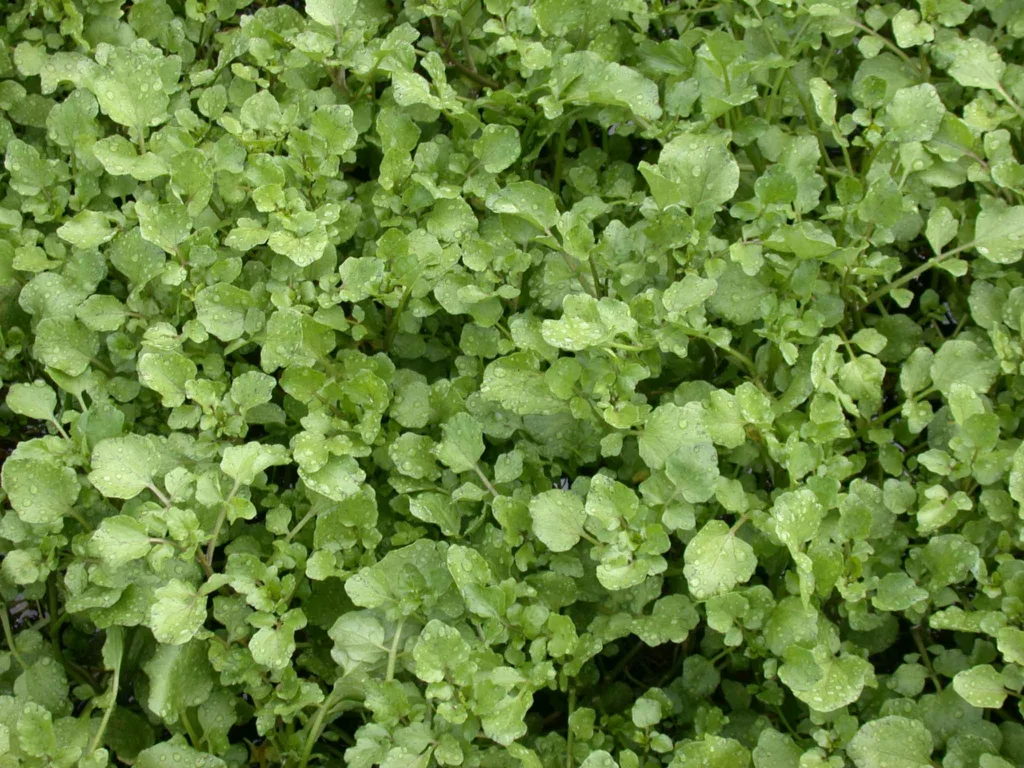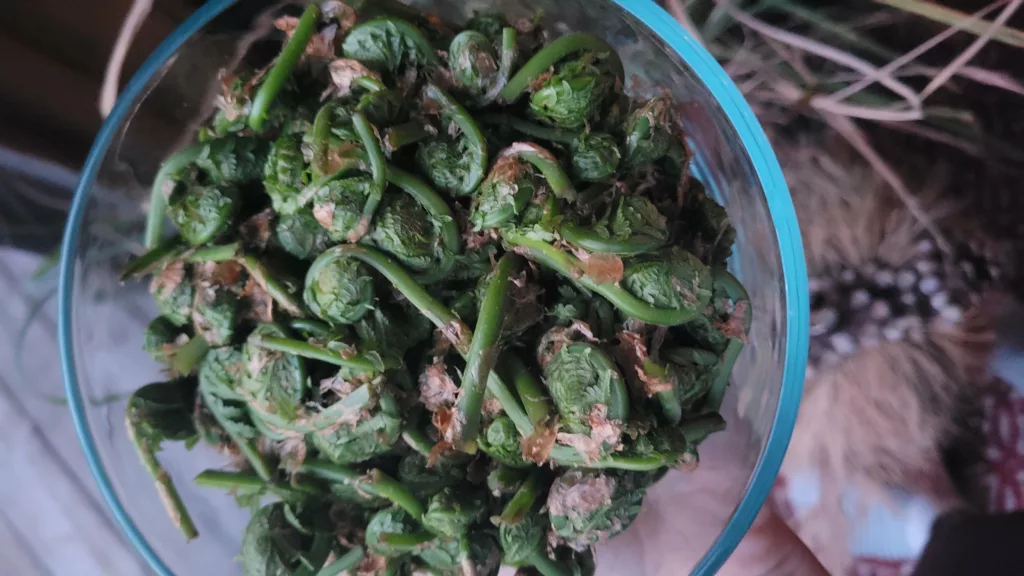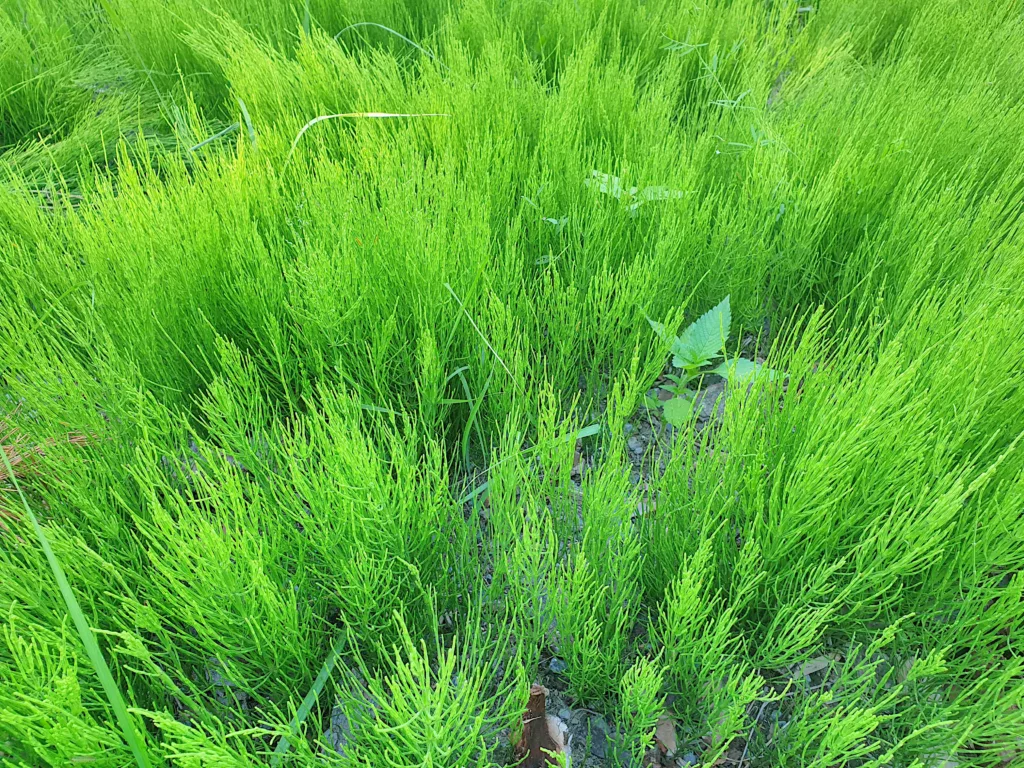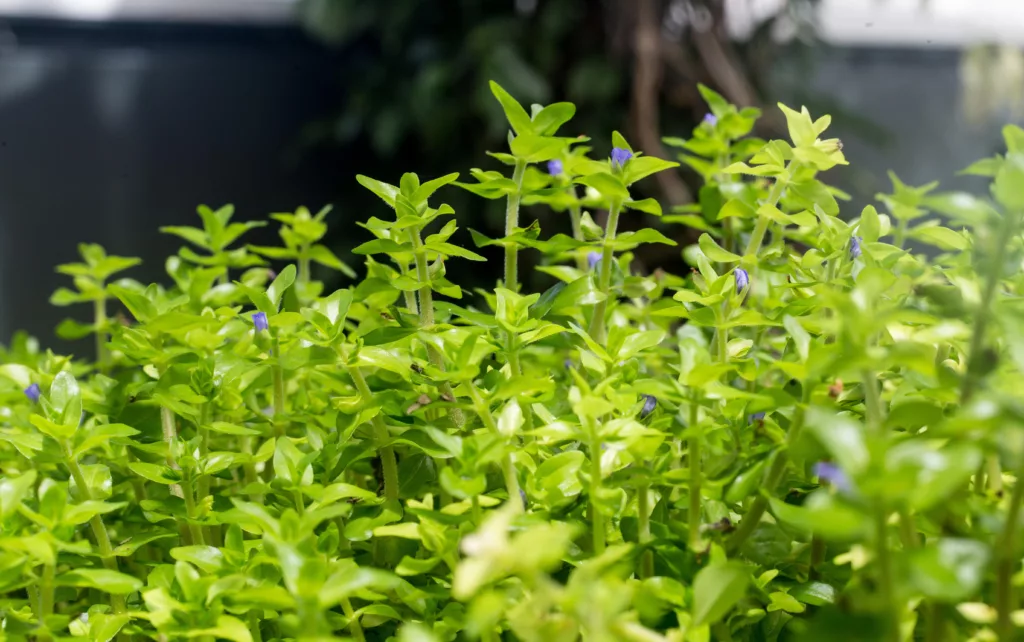This post may contain affiliate links. If you use these links to buy something we may earn a commission. Thanks.
Plenty of tasty herbs prefer and tolerate growing in wet soils with poor drainage. You’ll not only find all the best water-loving herbs but the ones that will tolerate wetter-than-ideal conditions so you can pick your favorites from a wide selection.
First, let’s address and define “wet soil” because many people recommend basil (for example) as an herb that grows in wet soil.
Basil, however, prefers well-draining moist soil. It doesn’t do well in wet or waterlogged soils in our experience. While basil is a moisture-loving plant, it is not a wet-loving plant. Constant wet soil will suffocate basil plants. Moist soil offers airspace, and wet soil does not.
I think the confusion stems from defining what “wet soil” is!
“Wet soil” means waterlogged or poor draining. Poor drainage means water drains very slowly, but eventually drains sometime within the day or few. Waterlogged soil means it takes days, even weeks to begin drying up, either from extremely slow drainage or evaporation.
Areas that tend to get plenty of water and stay wet for some time are perfect for plants that need lots of water.
Watercress, sweet flag, water mint, ostrich ferns, marshmallow, water parsley, skirret, horsetail, angelica, boneset, iris, and cattail are the best herbs that grow in wet soil and need lots of water.
After detailing what you can use all these water-loving herbs for, I’ll also share the best wet-tolerant herbs. That way you’ll have as many possible options to choose from for a successful garden.
See more wet-soil choices:
If you have a few feet or more of wet soil, planting a variety of these choices will result in a high-functioning ecosystem! Many of these options restore the soil, stabilize it, aerate it, and are also edible or medicinal in many ways!
Disclaimer: Food Forest Living or its authors are not responsible for what you choose to consume. Do your own research before consuming as an “edible” or using any herb for medicine. Before planting any of these options check with your local invasive plant council or regional extension office for guidance on plants that may be invasive in your area.
Watercress (Nasturtium officinale)

If you have consistently wet soil (even seasonally wet soil) semi-aquatic plants are your best friend!
Watercress is a vibrant, useful, and nutritious herb to grow that loves wet soils. Consistent moisture or shallow water is appropriate.
It also stabilizes soil and prevents erosion along water-line edges such as streams.
It grows best in zones 5-9 but can be grown in colder or warmer areas with the right care and positioning.
It prefers dappled or partial shade but tolerates full sun if extra moisture is present. Watercress doesn’t tolerate droughts.
You’ll find that watercress thrives in cool temperatures. Spring and fall will be the best times to harvest as the summer heat might cause lower-quality leaves.
I love the peppery taste and the slight succulent texture of fresh watercress. I wasn’t a salad person before I grew my own greens and this is a nice one to add. It’s considered a ‘superfood’ as it contains high amounts of vitamins, minerals, and antioxidants.
Other than salads, add watercress to soups, and sandwiches, or garnish anything with it.
Sweet flag (Acorus calamus)

Sweet flag looks quite like your typical iris. The differences, however, are something to consider when choosing one of the other.
Firstly, sweet flag is native to Eurasia. If you live there, consider choosing the vibrant green sweet flag. If not, Irises may be a better choice as they have a wider native range. Sweet flag, however, if not considered invasive in all regions beyond its native range. So check with your local area before planting.
More about sweet flag:
The roots of sweet flag extract oxygen from waterlogged soil making it well adapted to waterlogged and wet soils. It also tolerates marshy and swampy standing water for extended periods.
Full sun is the best, otherwise, part shade with at least 4-6 hours will keep sweet flag thriving.
This water-lover does best in zones 4-9.
This plant is often used for visual interest, fragrant leaves, medicine, pest repellents, erosion control, and restoring wetlands.
A small business Etsy shop Floridaseeds1 currently offers seeds for planting sweet flag!
Iris (Iris spp.)

Yellow flag iris (Iris pseudacorus), of most other irises, grows best in wet soils. This variety grows very large when in wet soils and it is semi-aquatic.
If your local nursery doesn’t offer this type of iris, you can get “Water Iris Versicolor” from Nature Hills Nursery and order everything online. This is another iris variety that grows well in wet soils.
Other iris varieties will generally tolerate standing water or wet soil but prefer well-drained soil. Waterlogged clay soil isn’t ideal for most irises.
6-8 hours of sun in a day is perfect for any iris.
Grow them in zones 3-9. Varieties such as ‘Arctic‘ can grow in zone 2!
People grow irises for their striking pollinator-friendly flowers, grass-like foliage, and low maintenance.
This herb is used medicinally and typically referred to as “orris root” which is the rhizome of an iris.
Water mint (Mentha aquatica)

If you’re a mint lover, water mint will thrive in wet soil and make what seems like a useless area, useful!
Like most mints, it does spread rapidly, but vigorous spreading is usually only an issue if you don’t use or manage the plant. So, if you’re a mint lover, harvest every summer and stock up on tea!
Water mint grows in moist or wet soil. So it will grow beyond the wet or waterlogged areas.
Ostrich fern (Matteuccia struthiopteris)

Ostrich ferns are edible and native to North America. Win-win!
Not only are they gorgeous, but thrive in a range of moist, medium to wet, and wet soils. They also have no problem adapting and growing in full-fledged swamps.
We harvest ‘fiddleheads’ to eat every spring! Free and delicious food. The rest of the year, their foliage is gorgeous to look at.
As easy-going as they are, they are low-maintenance and hands-free food.
Grow most kinds in zones 3-7.
People grow ostrich ferns for the added benefit of a spring edible treat, but also for their vibrant feathery foliage and soil-stabilizing roots.
You can order regular ostrich ferns or the ‘King ostrich fern’ here. The difference between the two is size! If you want it for spring food, I recommend the kind ostrich fern as the shoots will be much larger.
Order 1-3 plants and divide the rhizomes regularly to expand your patch over time. The more you order upfront the faster your patch will become bigger!
Marshmallow (Althaea officinalis)

Marshmellow is accurate to its name, they love growing in “marshes.”
People use several parts of this herb for multiple things. The root acts as a thickening agent when dried and powdered. The leaves and tender shoots are edible as is or cooked.
Marshmallow is also used as a medicine around the world helping to maintain respiratory health.
It’s also gorgeous to look at with pretty pink (or white) flowers. The flowers can be steeped for a throat-soothing tea.
Plant this in soil that stays constantly moist or wet. Some drainage is ideal as waterlogged and standing water isn’t ideal for marshmallow.
Its function is to stabilize soil along water lines. So typically, in its chosen setting they are elevated from the water and holding the small hillside together.
Four or more hours of direct sun is the best position.
Grow in zones 3-9.
Look for your favorite marshmallow here. (Etsy is my go-to for hard-to-find plants and seeds. Someone sells most things there! Just be sure to check reviews of the shop before ordering)
Water parsley (Oenanthe javanica)

This is about the most typical ‘herb’ on this list in terms of herbs you might have been hoping to find.
I love flat-leaf parsley. It had to grow on me, but it quickly did when I found out it’s delicious (and nutritious) when combined with lemon juice, salt, red onion, and cucumber—chop the red onion finely, coat in some salt, and add fresh lemon juice. Let that sit while you finely chop your parsley and cucumber, stir it up, and add to a salad with more ingredients or eat as is.
Water parsley, however, is milder than regular parsley. It’s a mix between parsley and celery in taste. So if my quick ‘recipe’ above hasn’t convinced you to try it then maybe this might!
Anyways, back to the details of this aquatic version of parsley!
Water parsley grows in consistent moisture and wet soils from sand to clay. Standing water is less ideal for it to thrive but can tolerate it for short periods.
It grows best with a minimum of 6 hours of sun in a day. Full sun positions are best!
Grow in zones 5-9.
The smell of freshly cut parsley is divine! And people like me grow it because it’s edible for various meals or garnishes.
Water parsley is used most for restoring wetlands, habitat for wildlife, looking attractive, and fresh eating.
Order rare water parsley seeds here.
Skirret (Sium sisarum)
A perennial root vegetable that needs moisture!
Skirret is a not-very well-known herb that grows in zones 4-9 and prefers moist and wet soils. Standing water and waterlogging, however, is not ideal.
The perfect position would be next to an area that has standing water and full or partial sun.
People grow this to savor their sweet but nutty carrot-like roots. Eat them raw or cooked in various meals.
Skirret is a valuable source of energy and nutrients, and while rarely heard of today, it was a common food source historically.
Not only can you eat this plant, but it looks good in the landscape, and aerates waterlogged soils by growing the taproots that it does!
Cattail (Typha spp.)

In our area and many others, cattails are endangered!
You’ll be providing everyone a service by planting cattails and only harvesting from your own patch in a regenerating manner.
Cattails are a very useful and edible herb!
They are aquatic and grow in moist, medium-wet soil, wet soil, and waterlogged/standing water.
They choose to grow along the edges of ponds, lakes, ditches, and inside sunny wetlands. They need full sun conditions and adapt to various soil types, including clay.
Cattails grow in zones 3-10 depending on variety and species.
Critical for ecosystems, they purify water, stabilize soils and provide habitat for necessary wildlife. Birds, mammals, insects, and various critters nest in the dense foliage.
The young shoots are edible and can be eaten as a vegetable. Other parts of the plant offer many creative uses.
And finally, they are gorgeous! No pond or marshy spot of a food forest should be without cattails.
Order sustainably harvested seeds here.
Horsetail (Equisetum hyemale)

Horsetail has been notorious for taking over my annual garden beds, and fast! And it’s no wonder since we have poor draining and waterlogged soil beneath the raised rows (for now).
Horsetail loves growing in moist to wet soils and even grows in standing water up to several inches. But they dislike being submerged.
People grow horsetail for its high levels of silica, minerals, and antioxidants. Silica is used as an abrasive material for cleaning and polishing surfaces. Its qualities have been used to improve skin, hair, and nails in traditional medicine.
Full or partial sun is best for horsetail and although it’s naturally growing in places I don’t particularly favor, it is a useful plant. A lot of people wish they could find some, and here I am ‘complaining’ to have it!
Angelica (Angelica archangelica)

Angelica thrives in moist and wet soils—it can’t ever be dry. This sweet fragrant herb is used to make perfumes, liqueurs, and medicines.
You’ll find angelica growing near streams, rivers, and meadows in its native range from Europe to Asia. In general, it isn’t known to be invasive to other areas. It grows well in zones 4-9.
This herb reaches 6 feet in height with large umbels of flowers that attract pollinators.
Water hyssop (Bacopa monnieri)

Water hyssop is a gorgeous subtropical aquatic herb with pretty little flowers. It thrives in moist soil, wet soil, and bog gardens of water features. It tolerates submersion or partial submersion.
White or purple flowers pop from vibrant somewhat succulent little oval leaves.
This herb has been known for supporting brain health through teas, tinctures, or other means of extracts to consume its medicinal compounds.
Grow it for visual value and erosion control. Its fine features combined with dense growth make for charming appearances.
Plant in zones 9-11 with 4-6 or more hours of sunlight.
Water plantain (Alisma plantago-aquatica)

This water-loving herb, known as either water plantain or mad-dog weed, needs consistently moist, wet, or waterlogged soil to live and thrive. Partial or full submersion under water is tolerated.
It’s native to Europe, Asia, and North America and grows in zones 4-8.
The roots and rhizome of water plantain have been used in traditional medicine as an anti-inflamatory and other uses.
This herb also provides soil stability and habitat for wildlife such as birds, insects, and amphibians.
This plant filters water by absorbing excess nutrients and pollutants resulting in a healthier environment.
Its distict foliage and tall flower stalks add unique interest to a wet landscape.
Water avens (Geum rivale)

Water Avens is a gorgeous water-loving herb with flowers often used in arrangements!
Grows in moist to wet soils. Tolerates flooding. Full or partial sun in zones 4-8 is best.
Used in traditional medicine for a variety of ailments.
Native to North America, Europe, and Asia.
Like most other water-loving plants, they control erosion, and provide habitat, and attractive foliage and flowers.
Rare and regular seeds available here.
Boneset (Eupatorium perfoliatum)

Boneset is a popular homestead-favorite herb and happens to love wet soil! Moist to wet soil is ideal, and drought is not tolerated.
It also thrives in wet clay soils—A gorgeous beauty you can add to a “difficult” landscape! It chooses to grow in meadows, marshes, and along streams, it’s suitable for rain gardens and tolerates floods with short periods of standing water.
Boneset is native to North America, grows in zones 3-8, and is used to remedy multiple things and is known as “the forgotten fever remedy.”
Small white flowers bloom in clusters from later summer through autumn. Plenty of pollinators are attracted helping to maintain a diverse range of predator insects for a thriving ecosystem.
The leaves or flowers of this herb have been used for teas or tinctures to alleviate fevers, colds, and flu.
Check seed availability here or here.
7 Herbs that Tolerate Wet Soil
Plants that tolerate wet soil will still grow happily but are less likely to thrive at their full potential in overly wet areas.
Moist soil with drainage is ideal for the list of herbs below, but wet soil for short periods shouldn’t be an issue!
Comfrey (Symphytum spp.)

Comfrey is an extremely tolerant herb in general. Once planted you won’t be getting rid of it! But it’s an amazing chop-and-drop plant for feeding gardens with green manure.
This herb can also be used as a topical remedy for various wounds.
Consistently moist soil is ideal but comfrey can live in poor draining areas. Prolonged water-logging, however, may cause it to suffer.
If you’re interested in adding this functional herb to your ecosystem, be sure to get a sterile version. We have the bocking-14 strain. All you need is a small bit of root to grow a plant that you’ll never get rid of.
So don’t damage the roots of an established plant, or attempt to dig it up for removal—you’ll end up multiplying the plant with every cut!
Vietnamese coriander (Persicaria odorata)

While different from classic cilantro, this herb is also grown for its unique flavor. It loves humidity and prefers consistently moist soil and also grows well when the soil is wet. It tolerates waterlogging.
You can grow this delicious herb in zones 10-11, as a perennial, or as an annual in cooler climates.
Also known by the name “Rau Ram.”
Japanese knotweed (Fallopia japonica)

Not an herb I suggest intentionally planting, but maybe you’ll find it growing where you have wet soil.
If you do have it, and have an interest in making medicine, it does have properties worth adding to your very own “farmacy” or if you’re a beekeeper.
It’s easiest to spot Japanese knotweed in late August to September. The cream-colored flower clusters are a giveaway when combined with the spade-like leaves that alternate down the stem. More identification information here.
Ordering and planting seeds is not recommended.
Skullcap (Scutellaria spp.)

Skullcap is known for being used as a sleep aid, however, not recommended for long-term sustained use. It can be consumed as a tea or tincture.
It grows best in moist soils but tolerates both dry and wet conditions. Native to North America in zones 3-9.
Joe Pye weed (Eutrochium spp.)

Joe Pye weed is a wonderful edible herb, beneficial for pollinators, and offers medicinal opportunities too. Green vibrant foliage is accompanied by pink flowers in August and September.
This herb loves consistent moisture or wet soil and suffers in dry conditions. It grows in zones 4-9 and is native to Eastern North America.
Meadowsweet (Filipendula ulmaria)

– medium to wet well drained’
Medium wet and well-drained soil is ideal for meadowsweet, but consistent moisture, and wetter than ‘medium’ will also suffice! Waterlogging is also tolerated.
Meadowsweet is another medicinal herb, said to help relieve pain and is consumed as a tea.
Catnip (Nepeta cataria)

Catnip is pretty resilient and can become invasive in some settings. It is, however, delicious as tea. Like other mints (nepeta), catnip is soothing and calming.
Catmint is different from catnip. Catnip is the one for cats! Catmint is a mintier-tasting version that appears more blue in color while catnip is a vibrant green.
It’s native to Eurasia but naturalized in Europe, North America, and New Zealand. Grow it in zones 3-9.
It prefers well-draining soil but handles plenty of water and moist or wet soils. Waterlogging or standing water is tolerated for very short periods.
Seeds are available here or here.
Conclusion
After putting together this post, it’s quite apparent that wet soil is an opportunity to start a pollinator paradise and medicine garden!
I’ve been drinking various homegrown herbal teas from this list and more and certainly feel good doing it!
With so many choices it can feel overwhelming trying to pick the right plants.
I recommend narrowing your list down to what grows in your zone, then sifting them through the “are they native?” strainer, and then doing individual research on what’s left for looks and uses.
Pick a variety of heights, colors, and growth habits to encourage diversity.
The most cost-effective way to grow a variety of these wet-soil-loving herbs is from seed and all of them can be found on Etsy. Growing from seed is also pretty reading. But if you don’t wish to do so, Nature Hills Nursery sells some of the plants on this list ready for transplanting.
Recent Posts
There’s no shortage of full-sun ground covers for zone 4 climates! Each plant in this list can withstand the frigid temperatures and also enjoy the hot sun in summer. Full sun means that a plant...
There's no shortage of full sun ground covers, not even in zone 3! Zone 3 climates offer hot but short-lived summers and very cold winters. So each plant in this list can withstand the frigid...
